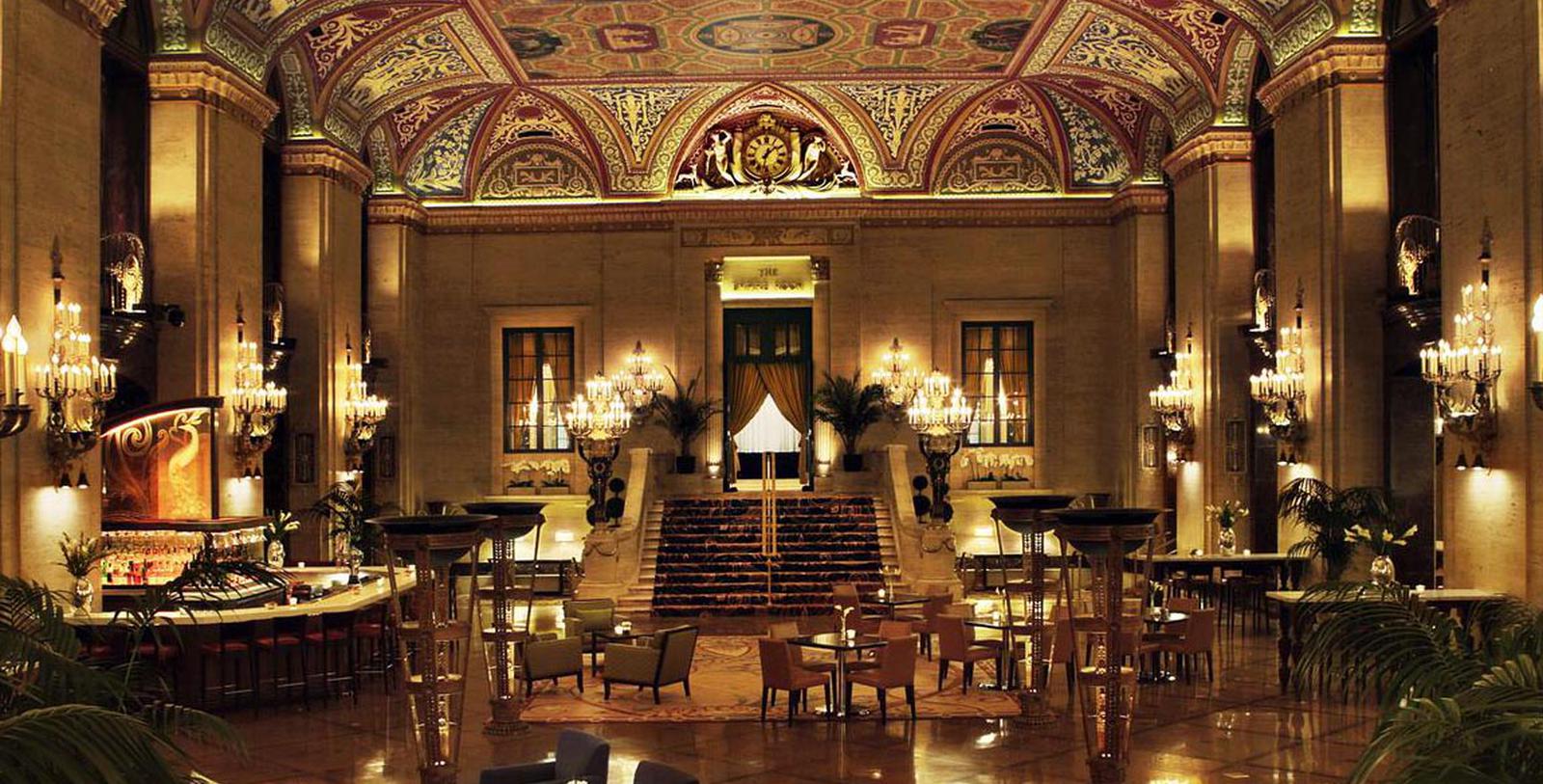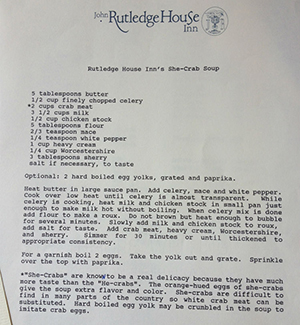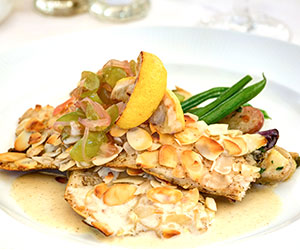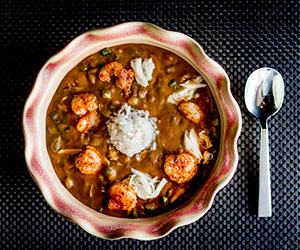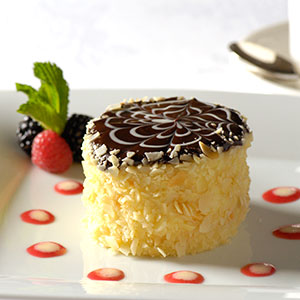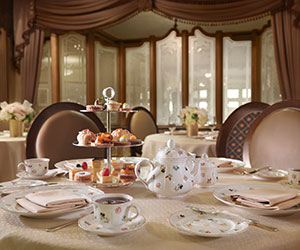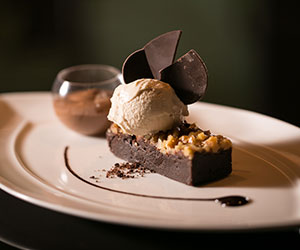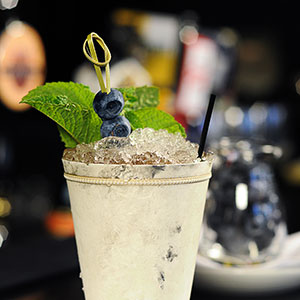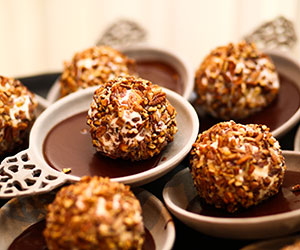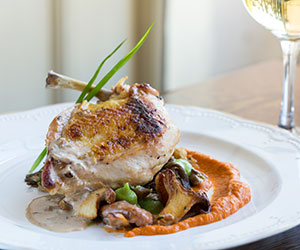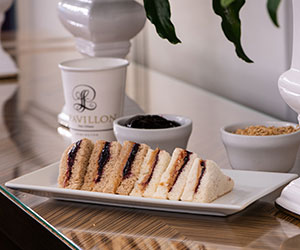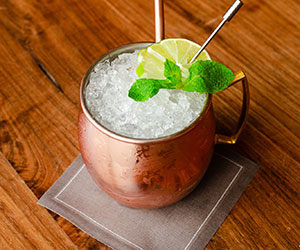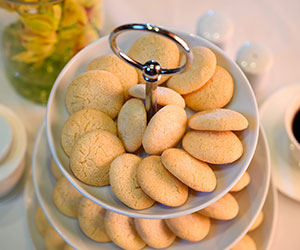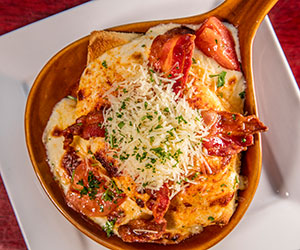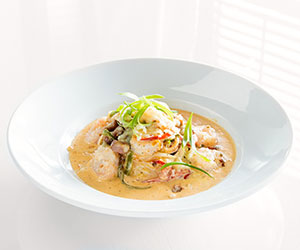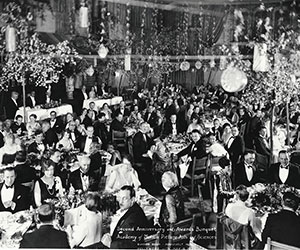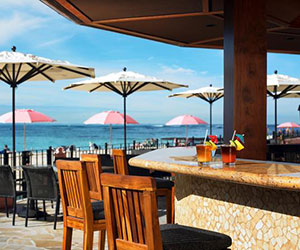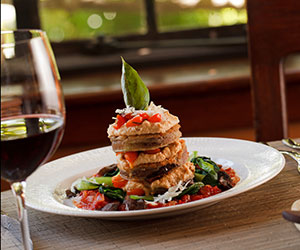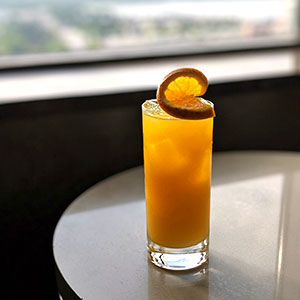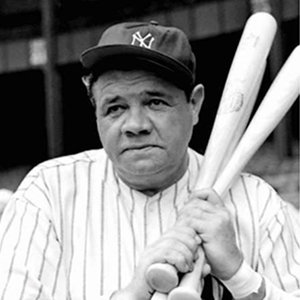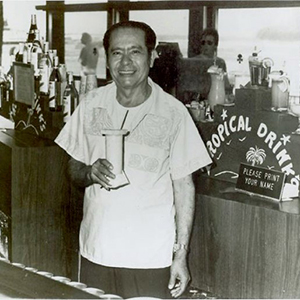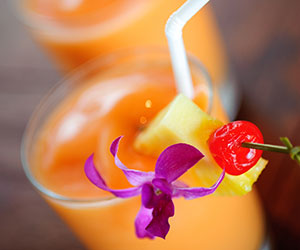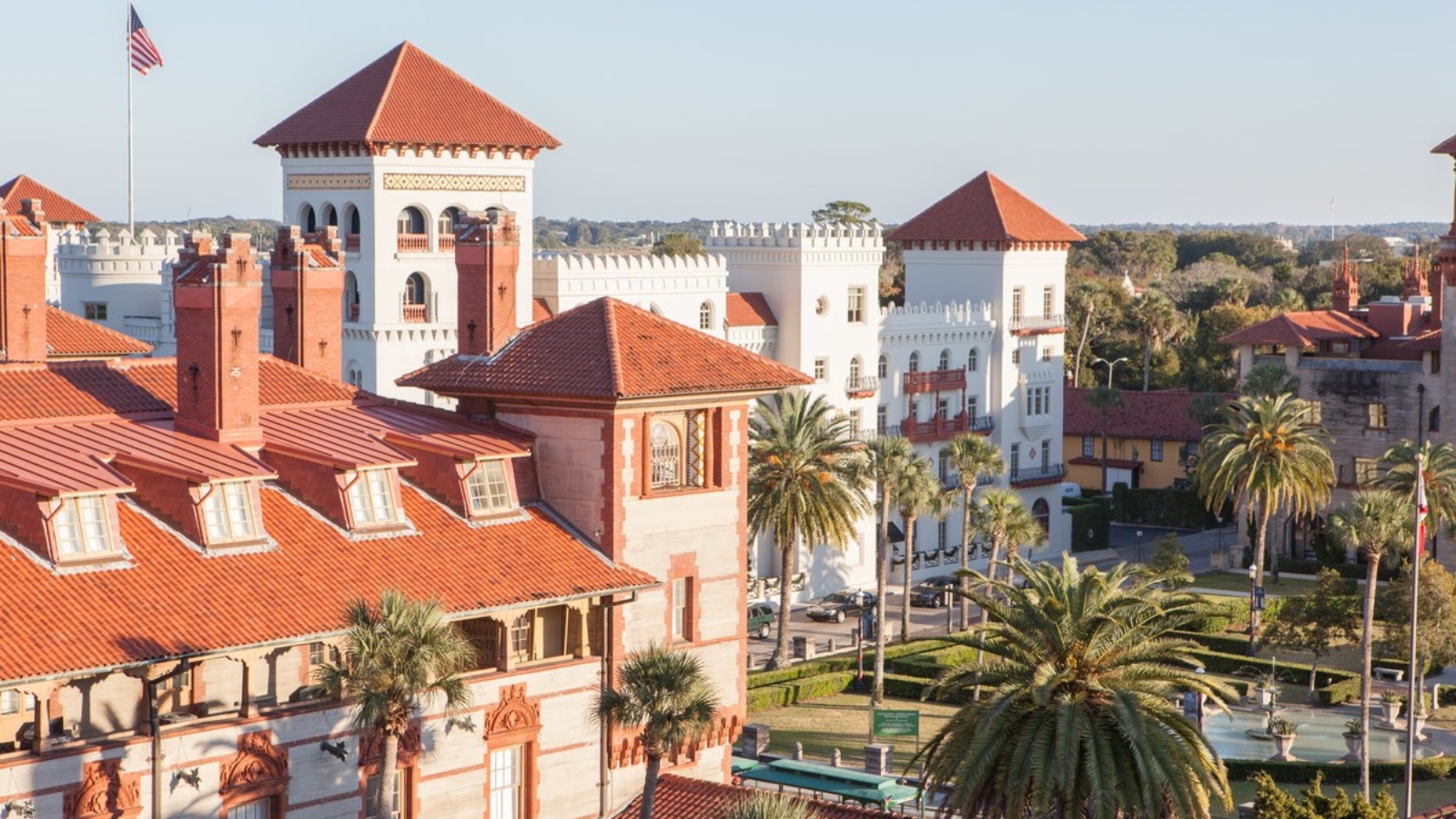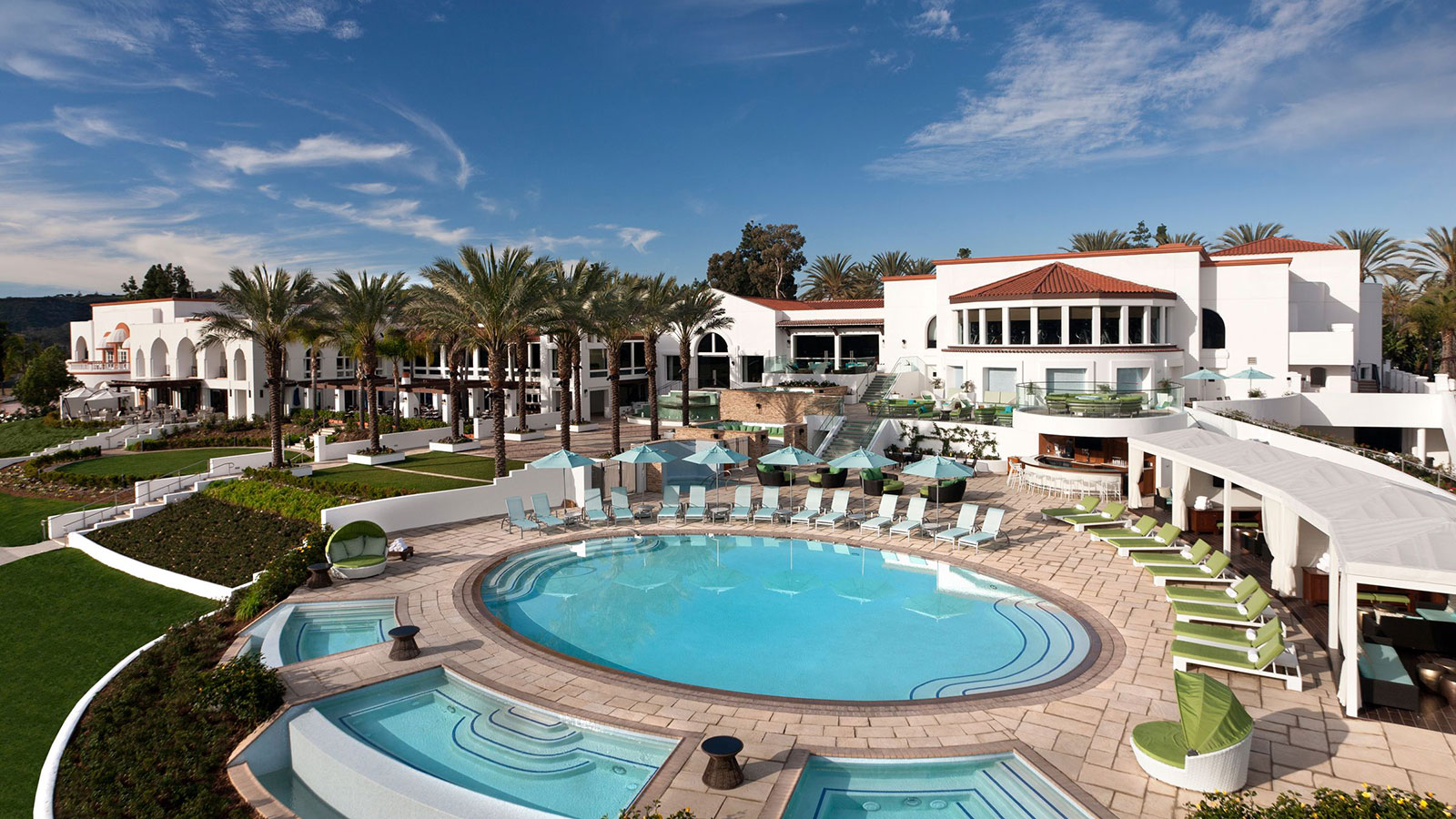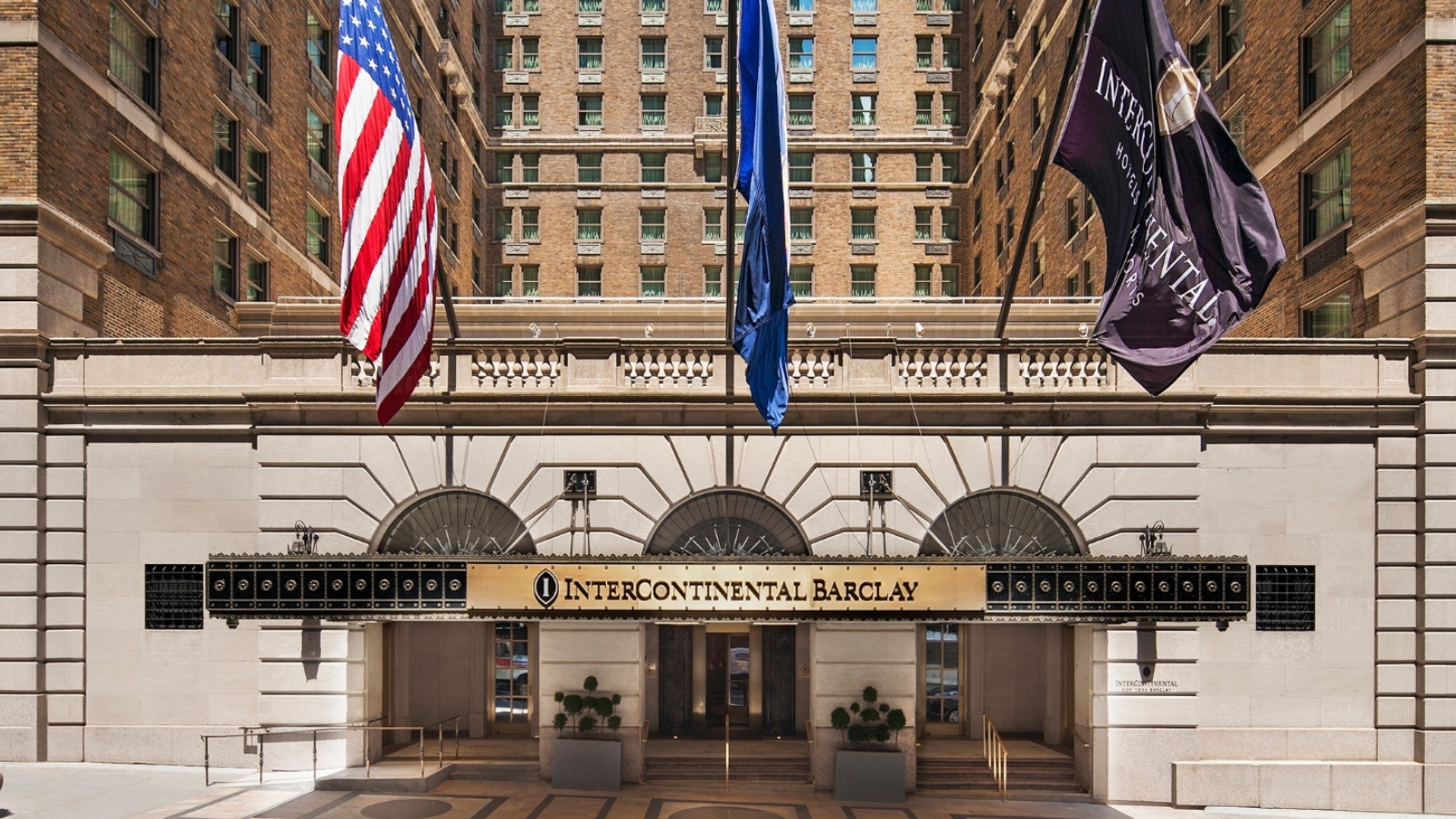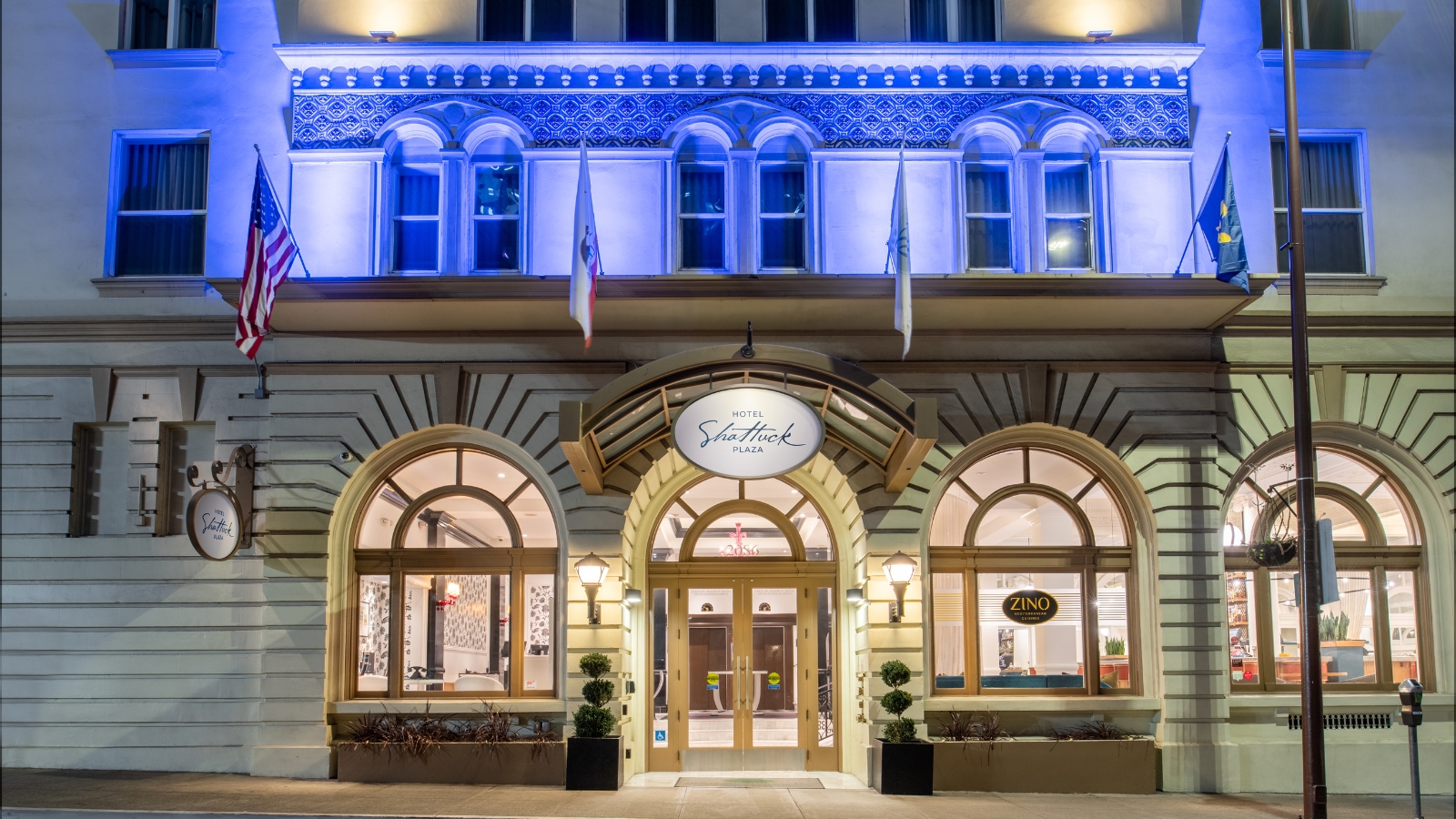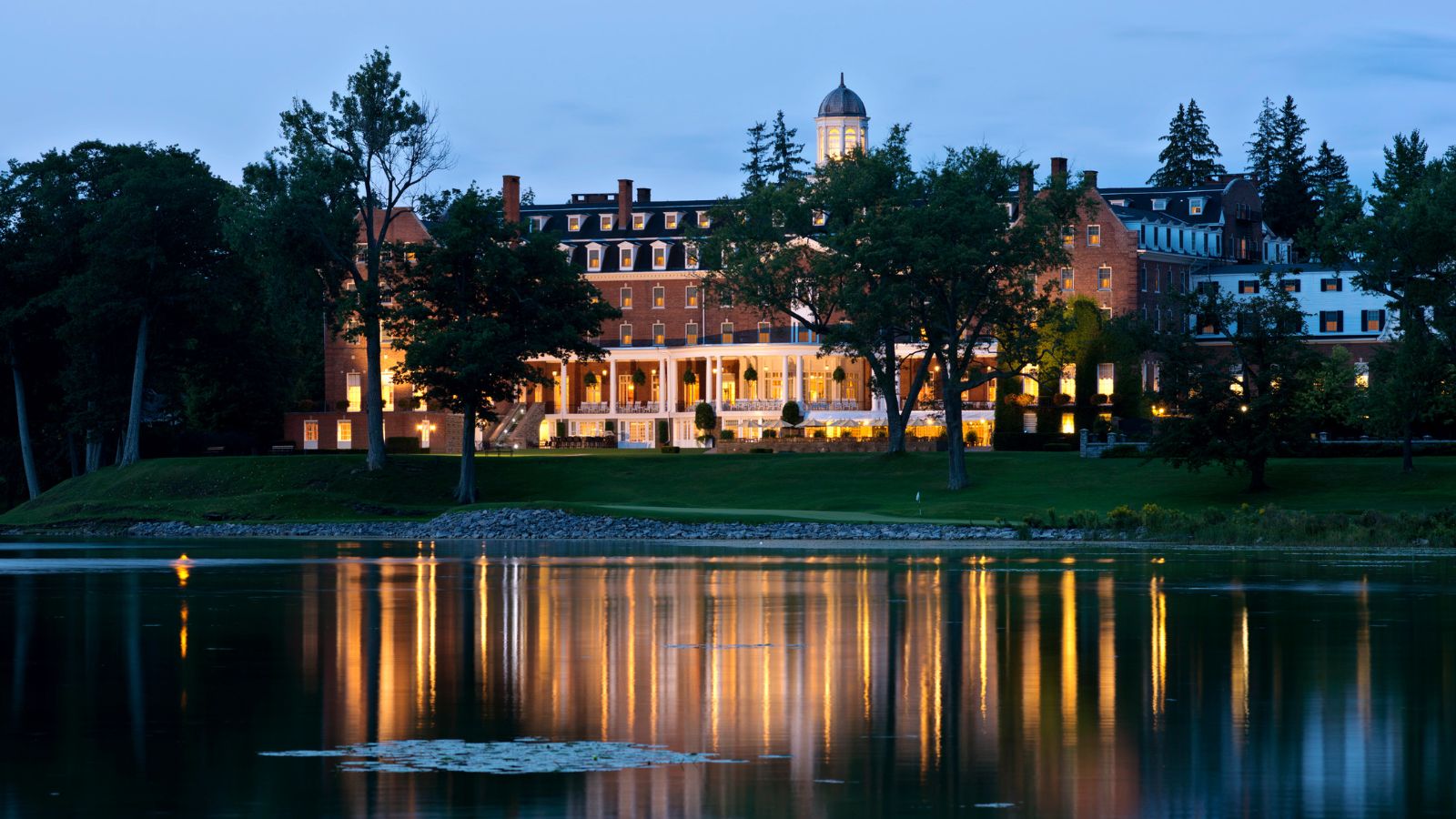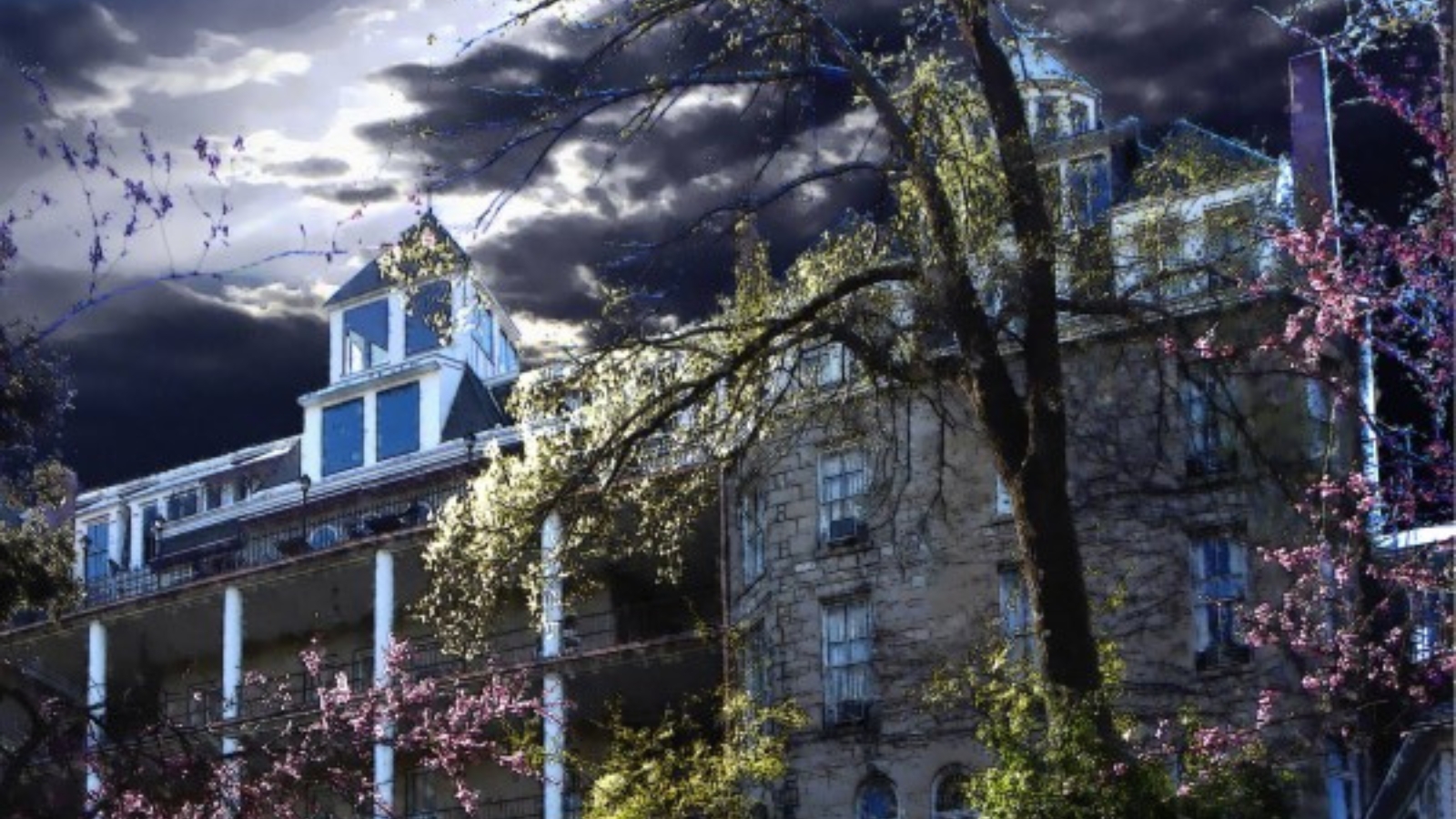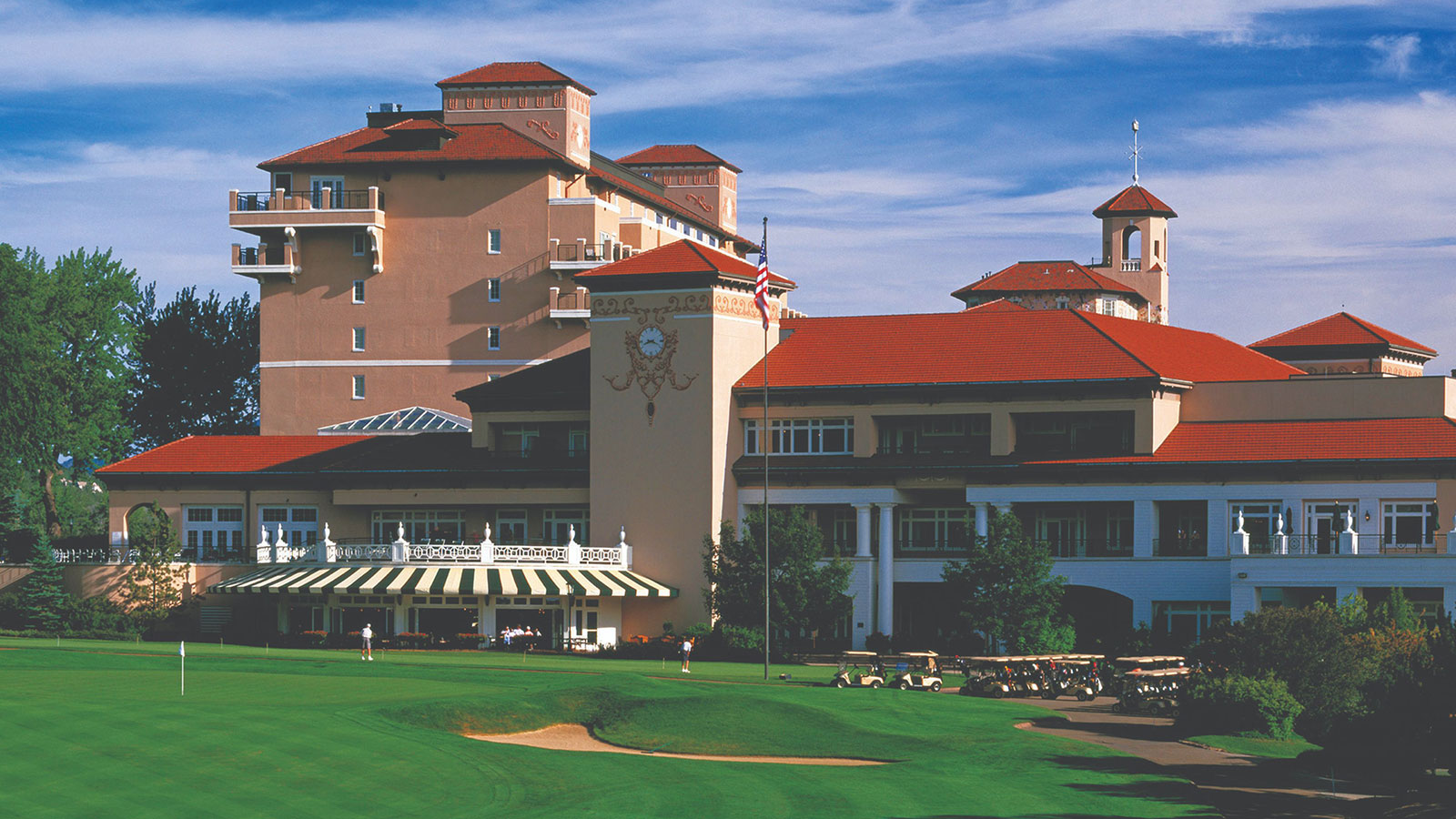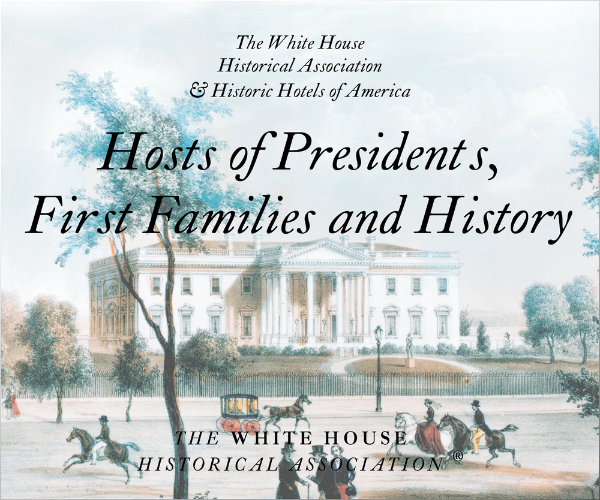Receive for Free - Discover & Explore eNewsletter monthly with advance notice of special offers, packages, and insider savings from 10% - 30% off Best Available Rates at selected hotels.
Culinary Heritage and Traditions


Culinary Heritage and Traditions
Historic Hotels of America has many iconic and legendary hotels that have made important contributions to the culinary heritage and traditions of the United States. From original recipes created at a hotel that have now become widely loved and enjoyed everywhere, to specialty drinks and cocktails that are deeply a part of the hotel’s history. For example, the famous Boston Cream pie, originally known as “Parker House Chocolate Cream Pie” was invented more than 130 years ago at the Omni Parker House. In 1996, Boston Cream Pie was named the official state dessert of Massachusetts. The chefs at Grand Hotel on Mackinac Island, Michigan created a pecan coated ice cream ball in 1947 and now serve more than 60,000 pecan balls each year. The “Shirley Temple” was first served at the Mai Tai bar of the Royal Hawaiian Hotel on Waikiki Beach. The famed drink the Blue Hawaii was created four years before the release of the Elvis Presley movie, Blue Hawaii, and was first served at the Hilton Hawaiian Village in 1957.
Here is the 2019 Historic Hotels of America List of Historic Hotels with the Most Unique Culinary Heritage and Culinary Traditions:
| John Rutledge House Inn (1763) Charleston, South Carolina In the 1920s, Charleston’s mayor Robert Goodwyn Rhett resided at what is now the historic John Rutledge House Inn. The Mayor was expecting a visit from U.S. President William Taft during his tour of Charleston. Wanting to do something special for the President, Mayor Rhett asked his butler, to “dress up” their typical crab soup. His presidential variation featured orange crab eggs, giving the soup bright color and great taste. Thus, She Crab Soup was born and began a legacy and practical rite of passage for all Charleston foodies. |
| The Omni Homestead Resort (1766) Hot Springs, Virginia Fresh, local trout has been a popular menu item at The Omni Homestead for more than a century. Allegheny Mountain Trout has been a guest favorite at this hotel for generations and is still served today in the hotel’s Dining Room. While the dish has been updated over the years, it is currently features Sautéed Allegheny Mountain Trout Almondine and is served with marble potatoes, haricots verts, macerated grapes and brown butter sauce. The trout is sourced from the Virginia Trout Company, located less than an hour away from the resort, just outside of Monterey, Virginia in Highland County. The partnership between The Homestead and the Virginia Trout Company is one of the longest running between the resort and local food purveyors. The recipe was featured in Former Executive Chef Albert Schnarwyler’s 1989 book, Dining at The Homestead. |
| French Lick Springs Hotel (1845) French Lick, Indiana It was an early summer day in 1917 at the French Lick Springs Hotel when Chef Louis Perrin entered his kitchen ready to prepare the morning meal for a crowd of guests at The Springs Restaurant. Things were progressing well until the Chef realized that they had run out of oranges and couldn't make orange juice. Ever resourceful, Chef Perrin simply grabbed a handful of tomatoes and began creating a new beverage – tomato juice. Using ripe tomatoes, a touch of sugar and his secret sauce, the Chef created a new breakfast drink that was a huge success. News of the drink spread quickly throughout the country and people arrived at the hotel just to try the interesting concoction. Soon there were too many orders for tomato juice and The Springs kitchen couldn’t keep up with the demand. A tomato juice company was formed in French Lick and given the secret recipe in order to make the juice in large quantities for the hotel. But once folks had a taste for it, the demand for tomato juice increased substantially, and by 1928, canned tomato juice was available on the commercial market everywhere. |
| Grand Hotel Golf Resort & Spa (1847) Point Clear, Alabama George Allen "Uncle Bud" worked at the Grand Hotel as a chef for 44 years and debuted his gumbo when he started at the resort in 1960. Featuring fresh seafood from Mobile Bay and the Gulf of Mexico, the same recipe is used by chefs at the hotel today. A U.S. Army Veteran, Uncle Bud's gumbo was known to be shipped regularly to the governor's mansion in Montgomery, Alabama. Generations of hotel guests have enjoyed “Uncle Bud’s” delicious gumbo for many years. |
| Omni Parker House (1855) Boston, Massachusetts Boston Cream Pie, the custard-filled cake with chocolate frosting originally called the “Parker House Chocolate Cream Pie,” was created and served at Parker’s Restaurant from the opening of the hotel in October 1856. It became so popular that in 1958 it was fashioned into a Betty Crocker boxed mix and sold nationally well into the 1990s and is now the official state dessert of Massachusetts. The soft, buttery Parker House Rolls, dubbed “America’s first soft dinner roll,” was a top secret recipe until 1933 when U.S. President Franklin Roosevelt requested they be served at a White House Dinner. |
| The Peabody Memphis (1869) Memphis, Tennessee The recipe for Vanilla Muffins at The Peabody dates back decades. While no one knows exactly when they first appeared, the muffins were already a perennial favorite in the 1940s. When Marilyn Belz (of the Belz family that many decades later came to own the hotel) and her friends would stop in for a late bite after dancing the night away to one of the big band orchestras in the Peabody Skyway the vanilla muffins were what was served as a late night snack. Today the vanilla muffins are still sold as a popular breakfast item in Peabody Deli & Desserts. And they are an after-dinner ‘take-home’ in Chez Philippe and frequently sent to guests and clients as a treat. |
| Palmer House®, a Hilton Hotel (1871) Chicago, Illinois Bertha Honoré Palmer, wife of Chicago merchant, real estate developer and builder of the Palmer House hotel, directed the Palmer House chef to create a special dessert to be served at the Columbian Exposition World’s Fair in 1893. This confectionary delight we have come to know as the brownie was created in the Palmer House Kitchen in the late 19th century. The recipe is well over a century old, and is the same one used for the brownie served in the Palmer House Hilton today. It remains one of the hotel’s most popular desserts. The first reference to the “brownie” in America appeared in the Sears Roebuck Catalog published in Chicago in 1898. |
| Capital Hotel (1873) Little Rock, Arkansas On April 15, 1880 General Ulysses S. Grant hosted a dinner party at the Capital Hotel. This was an 11 course feast of local foods and preparations but was most noted for 15 toasts. General Grant was a devotee of Kentucky’s Old Crow Bourbon, one of the oldest brands for which the Northern soldiers developed a taste during the war. At the prospect of 15 toasts, however, General Grant made a tactical adjustment and drank Champagne throughout. The bedrock of the Capital Bar & Grill cocktail menu include many home-grown creations, most based upon vintage preparations including a number of pre-Prohibition drinks. They include the Crop-duster – a regional take on the vintage Aviation. This cocktail includes seasonal blackberries from the famous P. Allen Smith, garden designer, conservationist, and agricultural historian and preservationist; it is very seasonal and entirely dependent upon the year’s bounty. |
| Basin Harbor (1886) Vergennes, Vermont Grandma Beach's Apple Crisp, "A Basin Harbor Tradition A La Mode” has been part of Basin Harbor’s history since they opened in 1886. Ardelia Beach, first generation host and founder of the resort was the originator of Grandma Beach's Apple Crisp. It was her tradition to make it for every holiday and guests of the resort can still enjoy it today in the Red Mill Restaurant or the Main Dining Room of the resort. This dish uses locally sourced ingredients including Macintosh apples from various orchards around Vermont as well as apples grown on trees found throughout the resort. |
| Grand Hotel (1887) Mackinac Island, Michigan The Grand Pecan Ball is Grand Hotel’s signature dessert and has been served since 1947. The recipe was adapted from the L.S. Aryes department store that opened in Indianapolis in 1872. There was a tea room in the store and the pecan ball was a memorable dessert. The owners of the Grand Hotel enjoyed it so much that in 1947 they hired someone to recreate it to be served at the hotel. It very quickly became the resort’s most popular dessert and it is still loved by guests today. The hotel prepares over 60,000 Grand Pecan Balls every year. |
| Union Station Hotel Nashville, Autograph Collection (1900) Nashville, Tennesse One of Nashville’s most iconic landmarks, the Union Station Hotel served as the city’s railway station for many years. The hotel’s past life is apparent in the hotel’s stunning preserved architecture—the soaring barrel-vaulted ceiling, and 100-year-old stained glass. Every so often, guests are also reminded of the building’s rich history through another kind of encounter: with the hotel’s resident ghost, Abigail. Legend has it that during World War II a young woman, Abigail, said goodbye to her soldier on the Union Station train platform before he shipped off to France. When she arrived at that same spot to greet him on his return, she was instead met with word that he was killed in action. Distraught, Abigail threw herself in front of a passing locomotive far below. The forlorn spirit of Abigail, still looking for her lost love, can reportedly be seen wandering the main terminal and her presence felt in Room 711. Abigail’s story also lives on at the hotel’s bar and restaurant in the grand lobby, Carter’s—The Abigail cocktail is a signature libation made with local spirit Picker’s Vodka, St. Germain, grapefruit juice, lemon and bubbles. |
| The Bellevue Hotel (1904) Philadelphia, Pennsylvania XIX restaurant provides an authentic Philadelphia experience, capturing the feel and boldness of the “Grand Dame of Broad Street” while curating a modern interpretation of the history of this hotel. The menu features exceptional flavors and superior quality, always served on the principle of using only the freshest, locally sourced ingredients. This philosophy is epitomized in the Green Circle Chicken “ala King,” a modern version of the dish William "Bill" King, a chef at The Bellevue created years ago. He was inspired to combine bits of chicken, mushrooms, truffles, sweet peppers, and cream in a mixture which is known to most as "Chicken a la King.” The Clover Club cocktail was created and named at the hotel when it was known as The Bellevue-Stratford and an homage to Mark Twain during one of his visits to the city of Philadelphia and the Clover Club, which was founded in 1882. |
| Le Pavillon Hotel (1907) New Orleans, Louisiana A symbol of its exceptional dedication to the desires of its guests, Le Pavillon Hotel began a unique tradition culinary in 1988. The staff at Le Pavillon learned of a traveling businessman’s family ritual of a late night peanut butter and jelly sandwich, with a cold glass of milk. This guest was missing his nightly ritual of peanut butter and jelly while traveling so often. Finding that none of the hotels could provide the homemade treat, he simply shared a cold glass of milk with his daughter many miles away, until Le Pavillon Hotel accommodated the request with a freshly made sandwich. Since that September evening in 1988, Le Pavillon Hotel invites guests to congregate in the lobby for a little taste of home. This delightful late night peanut butter and jelly snack is served with hot chocolate in the hotel lobby from 10-11 pm. |
| The Hermitage Hotel (1910) Nashville, Tennessee The Hermitage Hotel has a long history with Jack Daniels, Tennessee’s original whiskey which was established in 1866. The storied history dates back to the Prohibition era, when the notorious eighth floor suite was used during the suffragist movement and resulting in the 19th Amendment ratification in August 1920. Prior to the ratification the suite was often occupied by anti-suffragists who brought their own alcohol. It was used so often for those purposes that the suite acquired the nickname “The Jack Daniels Suite.” In the Prohibition era, a Tennessee statewide prohibition went into effect at the end of 1909, just before the hotel opened in 1910. Later, the hotel was caught serving liquor in teapots in 1912 as the city officials gradually cracked down. Jack Daniels has been a longtime partner with the hotel and has even created a special barrel blends made just for The Hermitage that are used in several drinks including the “Jack’s Mule.” This drink features Jack Daniels’ single-barrel whiskey, mixed with fresh ginger puree, lime juice and served over ice in a copper mug. Today, The Hermitage orders Jack Daniels by the barrel. |
| HOTEL DU PONT (1913) Wilmington, Delaware Served with all lunches, dinners, and banquet events in this historic hotel are the signature almond macaroons. So popular are these delicious cookies, that the bake shop makes more than 40,000 per month, in batches of 3,3000. Gluten-free and containing only four ingredients, the macaroon recipe is simple yet truly unique to HOTEL DU PONT. These macaroons have been baked in-house at the hotel for almost 40 years. These macaroons are served in the hotel’s signature restaurant, The Green Room known for opulent design elements that bring the elegance and grandeur of the Gilded Age into the 20th century. |
| La Fonda (1922) Santa Fe, New Mexico Chile Rellenos have been served at this hotel since 1926 when it was a Fred Harvey House. In 1925 the Inn was leased to legendary hotelier, Fred Harvey and it was operated as one of his renowned Harvey House Hotels for more than 40 years. These hotels were known for their hospitality, comfortable surroundings and delicious food for weary rail travelers. Today the tradition continues at La Fonda with a dish is known and loved, “Fred Harvey’s Chile Rellenos.” |
| The Brown Hotel (1923) Louisville, Kentucky One evening in 1926, the Brown Hotel’s chef Fred Schmidt grew weary of serving traditional ham and eggs and from that he was inspired to created the decadent Hot Brown open faced sandwich. It was an instant hit with guests and since then it has become one of the world’s most famous sandwiches and has received national acclaim in many popular publications. The delicious open-faced turkey sandwich is made with bacon, tomatoes and a delicate Mornay sauce and is a must-try when visiting Louisville. Since that fateful night, the Brown Hotel has served more than 1.5 million Hot Browns. |
| Francis Marion Hotel (1924) Charleston, South Carolina Shrimp and grits are a southern staple and a tradition in the Lowcountry. This dish has been on the menu at the Francis Marion for over 20 years. Originally, this dish was a breakfast item and made for fishermen. Once called ‘breakfast shrimp’ this dish was filling enough for their long hours of labor. Typically enjoyed through shrimp season, which runs from May-December these fishing families made their breakfast shrimp with simplicity. Just using shrimp cooked in bacon fat and plain grits, the dish was more of a necessity rather than the exquisite dish you find today. This award-winning dish can be found at the Swamp Fox Restaurant thanks to Executive Simon Andrew, who tweaked this regional and historic dish into the beloved one served today. Using local shrimp as well as regionally local grits from Adluh Mills, located in Columbia, South Carolina, Chef Simon Andrews is sure to source locally produced products for this historic dish. |
| The Mayflower Hotel, Autograph Collection (1925) Washington, D.C. The Mayflower Hotel has been making banana bread since the 1956 and it has become one of the hotel’s signature items, used as a turndown amenity, served in the hotel’s restaurant Edgar, and even as a dessert at many weddings held in the hotel. Fun fact about this bread, The Mayflower Hotel uses over 20,000 bananas each year to bake over 10,000 loaves of banana bread. The Mayflower Hotel credits the original 1956 recipe to the Royal York Hotel in Toronto. |
| Omni San Francisco (1926) San Francisco, California International tastemaker Willie Brown Jr., who served two terms as Mayor of San Francisco and 15 years as Speaker of the California State Assembly, is a frequent guest at Bob’s Steak and Chop House – the preferred gathering place for San Francisco politicians and power brokers. His favorite dinner entrée is the restaurant’s 14-ounce Rack of Lamb, which he proclaims is “the best in town.” Located at the Omni San Francisco, the classic steakhouse recently upped its appeal with a renovation that celebrates the location’s rich heritage in San Francisco’s Financial District, once known as the Wall Street of the West. San Francisco memorabilia, vintage banking photography, equestrian art and wine country artifacts reflect the city’s golden history and timeless style at Bob’s Steak & Chop House. |
| The Hollywood Roosevelt (1927) Los Angeles, California The Hollywood Roosevelt hosted the inaugural Academy Awards in 1929, and over its almost 90 years has welcomed illustrious icons through its doors, from Clark Gable, Shirley Temple, Charlie Chaplin and Marilyn Monroe who resided there, to Prince and Angelina Jolie. The menu served at the first Oscars was considered very upscale at the time and included dishes such as Consommé Celestine, Filet of Sole Sauté Au Beurre, Half Broiled Chicken on Toast, New String Beans, Long Branch Potatoes, and others. The hotel carries on the tradition of honoring the Academy Awards to this day, serving a modern day Oscars menu. In addition to the Oscar viewing menu, there are cocktails created with an homage to the leading ladies of the silver screen. |
| The Royal Hawaiian, A Luxury Collection Resort (1927) Honolulu, Hawaii In 1935 Shirley Temple visited Waikiki Beach and charmed the guests and staff in what is known as the “Pink Palace of the Pacific.” Keen to please their popular young guest, bartenders served a new drink (ginger ale and a dash of vibrant pink grenadine, garnished with a maraschino cherry) to Temple while she dined in the hotel’s opulent Persian Room. And thus the delicious drink we know as the Shirley Temple was born. |
| The Settlers Inn (1927) Hawley, Pennsylvania Ownership of this historic inn restored the building from a long ago abandoned hotel to a community focal point and gathering place. The restaurant was driven by the owner’s passion for organic gardening and farming and presenting food that would help preserve small family farming in the region. Local growers and producers were utilized to procure their products in a simple and direct manor to highlight the bounty of the region. Over the next 39 years the list of those supplying the Inn grew to over 25 direct to the restaurant providers. In addition the Inn’s extensive gardens produce the many edible flowers used in recipes and as decorative garnishes. The house smoked Blooming Grove Brook Trout has been a favorite at the hotel for almost 40 years. The trout has been sourced directly from one of the oldest mountain river hatcheries in the United States dating back to the 1880s. |
| Westin Portland Harborview (1927) Portland, Maine The Roosevelt’s Revenge cocktail is the Westin Portland Harborview’s take on a Harvey Wallbanger and dates back to 1946. This specialty cocktail features local Ice Pik vodka, Galliano and orange. The drink is a reference to when the former First Lady Eleanor Roosevelt was denied a room at the hotel (then known as The Eastland Hotel) because she was traveling with her beloved Scottish Terrier, Fala. The hotel is now proudly a pet friendly hotel and this craft cocktail can be found on at the Top of the East on the 15th Floor Lounge. |
| The Don CeSar (1928) St. Pete Beach, Florida In the 1930s, the New York Yankees signed a three year contract with the founder of the hotel, Thomas Rowe to stay at The Don CeSar for spring training. Part of their contracted agreements was that The Don must serve milk and steak for breakfast to the players on the team every day. Some of those players that would have eaten this hearty breakfast were Babe Ruth, Ty Cobb, and Lou Gehrig. |
| The Mimsyln Inn (1931) Luray, Virginia The Inn has been serving Shenandoah Apple Pie since they opened in 1931. Apple pie has been a signature dish at this hotel because a key ingredient of the recipe is grown on the property of the hotel: apples! Residents of the area remember when the hotel would make and then sell the fresh apple pies to the resorts along Skyline Drive. The apples of the Shenandoah Valley have a distinctive tart flavor that sets them apart from other apple pies. It is known that Johnny Appleseed was a notable resident of the Shenandoah Valley. |
| Caribe Hilton (1949) San Juan, Puerto Rico The Caribe Hilton is the birthplace of the Piña Colada. In 1954, the Caribe Hilton’s bartender Ramón “Monchito” Marrero created a special cocktail with mixed rum, coconut cream and pineapple juice – and the delicious Piña Colada was born! The drink was served personally by the creator for 35 years while he worked as a bartender at the hotel, and in 1978, the Piña Colada was declared the official drink of Puerto Rico. |
| Morris Inn at Notre Dame (1952) South Bend, Indiana The Morris Inn has a signature cocktail, The Dexter that harkens back to the early 1900s. As the story goes, in 1902, Notre Dame student Ernest M. Morris could not pay tuition. His dreams of a diploma slipping away, Morris asked the school president for two favors: to let him continue enrollment on credit, and to take care of his horse Dexter. Father John W. Cavanaugh graciously agreed. Morris graduated and went on to found his own investment firm. He donated $1 million to aid the University in its post-war expansion, and Morris Inn was constructed in his honor. Asked why he did so much in return for a small bit of kindness, Morris said, "I'll just never forget how kind Notre Dame was to my horse." Hence why the Morris Inn now offers their signature cocktail, The Dexter. It features Blanton's Bourbon, Cointreau, Sweet Vermouth and fresh lemon juice. Blanton's Bourbon is used in this particular drinks because its stopper features a horse. |
| Mauna Kea Hotel (1965) Kohala Coast, Hawaii Culinary traditions run as deep as the Pacific Ocean at Mauna Kea Beach Hotel. Mauna Kea Beach Hotel has sourced produce and product from Hawaii’s Big Island for well over 50 years, long before sourcing locally gained prominence and renown as “Hawaii Regional Cuisine.” Among treasured favorites on the menu are three standouts; Mauna Kea Banana Bread, the Ovaltine Froth, and the Fredrico cocktail. Guests are greeted each morning at Manta Restaurant with a slice of Mauna Kea’s flavorful banana bread. Home cooks have often tried to replicate the recipe but the secret to its success is tightly guarded in the hotel’s pastry kitchen where it is fresh-baked daily. The Ovaltine Froth’s beginnings are unknown. Did someone spill Ovaltine atop some ice cream and discover the cooling combination? Regardless, ask any of the many who indulge each day in the inexplicable refresher served beachside at Hau Tree Restaurant and they’ll attest that it is something they can’t wait to have during every visit to Mauna Kea Beach Hotel. The Fredrico cocktail is synonymous with Mauna Kea Beach Hotel’s Hau Tree Gazebo Bar. Created in the 80s for a thirsty golfer who wanted something both tropical and masculine, the Fredrico combines tropical juices with Jack Daniels for another inexplicably delicious concoction that conjures up the Spirit of Aloha with each sip. |
Read all our Top 25 lists:
Top 25 Most Haunted Historic Hotels
Top 25 Most Magnificent Gingerbread Displays
Top 25 Historic Hotels for a Romantic Proposal
Top 25 Most Magnificent Gardens
Top 25 Most Magnificent Ceilings and Domes





















